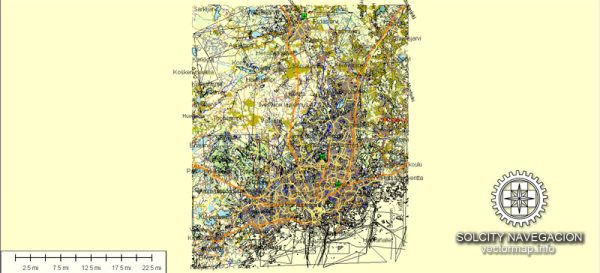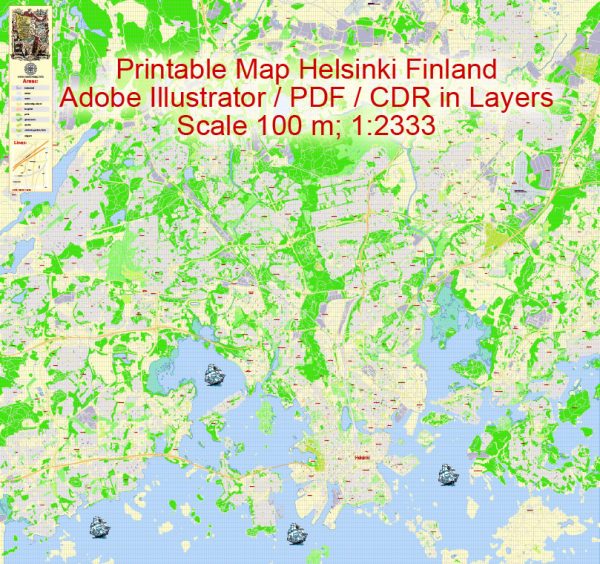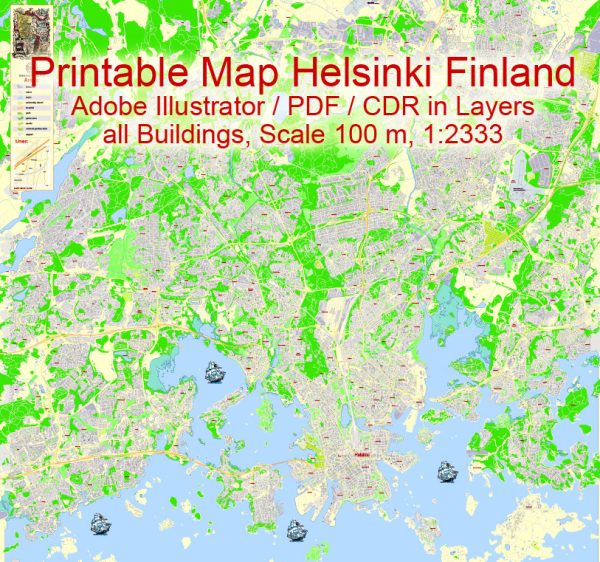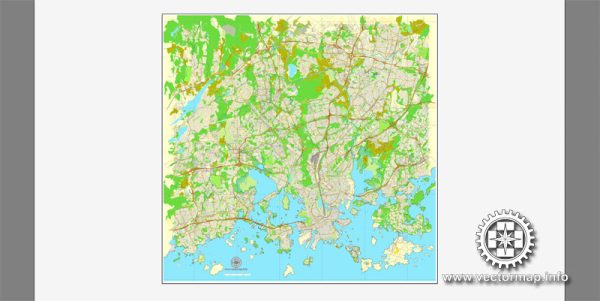Helsinki, the capital of Finland, has a rich history and a well-developed transportation infrastructure.
Vectormap.Net provide you with the most accurate and up-to-date vector maps in Adobe Illustrator, PDF and other formats, designed for editing and printing. Please read the vector map descriptions carefully.
Here is a detailed overview of both aspects:
History:
Ancient History:
- The area around present-day Helsinki has been inhabited for thousands of years by the Finno-Ugric people.
- Swedish influence began in the late Middle Ages when the Swedes established the town of Helsingfors in 1550, but it remained a small coastal village.
Swedish Rule:
- Helsinki grew slowly under Swedish rule and became part of the Kingdom of Sweden.
- In the 18th century, the construction of the Suomenlinna sea fortress began, marking an important development for the region.
Russian Influence:
- In 1809, Finland was ceded to Russia by Sweden, and Helsinki became the capital of the autonomous Grand Duchy of Finland under Russian rule.
- Significant urban development took place during this period, with the construction of various buildings and institutions, including the University of Helsinki.
Independence and 20th Century:
- Finland declared independence in 1917, and Helsinki continued to grow as the capital of the newly independent nation.
- The city played a crucial role during the Winter War (1939-1940) and the Continuation War (1941-1944) against the Soviet Union.
- Post-World War II, Helsinki underwent rapid urbanization and modernization, transforming into a vibrant Nordic capital.
Transportation Infrastructure:
Public Transport:
- Trams: Helsinki has an extensive tram network, providing efficient and eco-friendly transportation throughout the city.
- Buses: A well-developed bus system complements the tram network, connecting various neighborhoods and suburbs.
- Metro: The Helsinki Metro serves both the city center and its suburbs, providing a fast and convenient mode of transportation.
Rail:
- Main Railway Station: The Helsinki Central Railway Station is a major transportation hub, connecting the city to other parts of Finland and neighboring countries.
- Long-Distance Trains: Finland’s rail network connects Helsinki to cities like Turku, Tampere, and Oulu.
Air:
- Helsinki-Vantaa Airport: The main international airport serving the Helsinki metropolitan area, providing connections to major cities worldwide.
- Regional Airports: Other smaller airports, like Helsinki-Malmi Airport, cater to domestic and regional flights.
Sea:
- Ports: Helsinki has passenger and cargo ports, with regular ferry services to destinations like Tallinn (Estonia) and Stockholm (Sweden).
- Archipelago: The city’s proximity to the Baltic Sea and its archipelago influences maritime transport.
Roads and Cycling:
- Road Network: Well-maintained roads connect Helsinki to other parts of Finland and Europe.
- Cycling Infrastructure: Helsinki is known for its bike-friendly environment, with dedicated lanes and bike-sharing programs.
Future Developments:
Helsinki continues to invest in sustainable and innovative transportation solutions, such as expanding public transport networks, promoting cycling, and implementing smart city initiatives to improve overall mobility and reduce environmental impact.
In summary, Helsinki’s history reflects a blend of Swedish and Russian influences, while its transportation infrastructure seamlessly integrates various modes of travel, emphasizing efficiency and sustainability.





 Author: Kirill Shrayber, Ph.D.
Author: Kirill Shrayber, Ph.D.